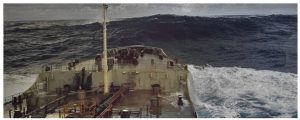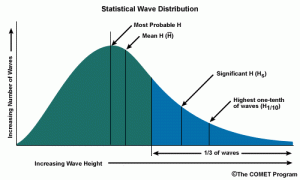There was a rogue wave incident involving the cruise ship Viking Polaris on November 29, 2022, at 22:40 local time, while the ship was sailing towards Ushuaia, Argentina. What is a “rogue wave incident”? Rogue, freak, or killer waves have been part of marine folklore for centuries but have only been accepted as real by scientists over the past few decades. This column is about that.

A rogue wave estimated at 18.3 meters (60 feet) in the Gulf Stream off Charleston, South Carolina. At the time, surface winds were light at 15 knots. The wave was moving away from the ship after crashing into it moments before this photo was captured. Courtesy: NOAA
“Surf Happens” – But How Do I Gauge It?
For the more scientifically inclined, the energy within a wave is proportional to the square of the wave’s height. Like many things in nature, a 4-foot wave isn’t four times as powerful as a 1-foot wave. Four-foot seas are sixteen times as energetic as one-foot seas, all else being equal. How much energy is in a 100-foot “greybeard” passing Cape Horn, compared to a 4-foot wave in Moriches Inlet? Do the math. Not 25 times more powerful (100’ / 4’) but 625 times more powerful! (100 squared / 4 squared)
But things are rarely equal. A long, slow, four-foot sea is one of life’s great pleasures at sea. What matters is how close together and how steep those waves are. A good way to compare waves for steepness is the wave height divided by the square of the frequency period. This is essentially how fast your sleighride is going to be – or the beating you’re going to take. Halving the frequency period (from, say, 10 seconds to 5 seconds) of a wave quadruples the acceleration of your sleighride, and more than likely multiplies the seasickness aboard. Another way to gauge what awaits you at sea is a Severity measurement. This indicates the amount of energy carried by each bit of wave and is proportional to the energy of a wave (the square of its height) divided by its wavelength (how much distance the waves are apart, measured from peak to peak.) As you can probably do in your head, 6-foot waves that are 6 feet distance, not time) apart are more severe than 6-foot waves that are 12 feet apart.
Anyone who has stood by the seashore and watched waves roll in must have wondered at least once, “When is the next big one coming?” And, sure enough, just out in the offing, you can see one that just seems head and shoulders above the others.
Traditions Die Hard at Sea
You’ve seen me make that observation before and it will always be true, by my reckoning. One of those traditions is that waves come in sets of seven, meaning that every seventh wave will be like the prior wave that passed earlier. Another way to think of that is that, once a big one has crashed ashore, the next one is but seven waves behind.
Of course, that isn’t true – but it is sort of true, meaning that waves are part of a hydrodynamic system and there are statistical probabilities that do apply. One of the more quoted oceanographers in this regard is Walter Munk, who began the systemization of waves, weight heights and predictability (and measurement) of waves. He started his work during World War II and won international awards and acclaim for his work for many decades after. Waves, or perhaps better said, “sets of waves,” are categorized by the “significant wave height” or Hsig, a formula intended to mathematically express the height estimated by a “trained observer.”
In oceanography, Hsig is defined traditionally as the mean wave height (trough to crest) of the highest third of the waves. But once you do that, you start to tease out the statistics of waves of varying heights arriving – and if you are a mariner out upon God’s Great Sea, this can be of intense interest…

Now this can get pretty intense, mathematically, but if you focus on the message and the technology, you’ll get all the information you need. Generally, the statistical distribution of individual wave heights is well approximated by a “Rayleigh Distribution.” For example, given that Hsig = 1 meter, or 3.3 feet, statistically:
· 1 in 10 will be larger than 1.2 m (3.6 ft)
· 1 in 100 will be larger than 1.5 m (5.1 ft)
· 1 in 1,000 will be larger than 1.9 m (6.2 ft)
This implies that one might encounter a wave that is roughly double the significant wave height. And remember what Hsig is – an expression of the highest 1/3rd of the waves. This means that two thirds are less than that…perhaps lulling the mariner into a false sense of security?
Converting that distribution into time at sea, where a wave passes your 25-foot vessel every 6 seconds:
· 1 every minute will be larger than 1.2 m (3.6 ft)
· 1 every 10 minutes will be larger than 1.5 m (5.1 ft)
· 1 in 100 minutes (1.7 hours) will be larger than 1.9 m (6.2 ft)
And this is when two thirds of the waves are less than ~ 3 feet. And, statistically, when two significant waves come into “phase,” it’s possible to encounter a wave that is much larger than the significant wave.
Groups of seven? No. But the big’uns are out there. “Both in safety and in doubt, always keep a good look-out*.”
If you are interested in being part of USCG Forces, email me at JoinUSCGAux@aol.com or go directly to the U.S. Coast Guard Auxiliary “Flotilla Finder” at cgaux.org/units.php and we will help you “get in this thing . . .” ■
* Eldridge Tide & Pilot Book




